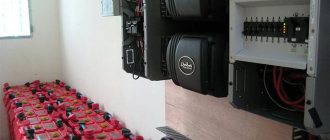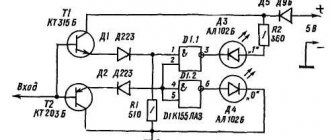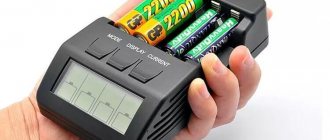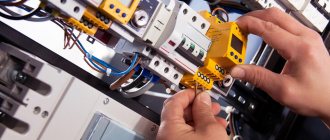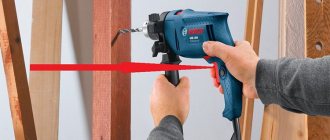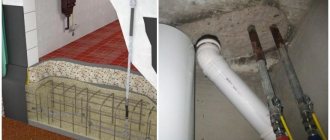No modern home can be imagined without electrical appliances. It surrounds a person everywhere and is in any room. Therefore, it is important to think about technical security. Some people buy special circuit breakers, while others prefer residual current devices.
A clear answer to the question: “which is better?” no, for each situation it is necessary to select the appropriate device. And to make this easier, the editors of the YaNashla website have prepared for you a rating of the best manufacturers of residual current devices (RCDs) for 2022.
Choosing an RCD for an apartment and a house - a checklist in 10 steps.
The residual current device is selected after you have divided all the electrical wiring into separate groups, calculated, and maybe even already laid the appropriate cable of the required cross-section and selected circuit breakers.
The choice of the RCD itself largely depends on these parameters.
Do not forget that an RCD is necessary not for protection against short circuits or overloads (automatic machines handle this matter), but to protect a person from electric shock.
To choose the right RCD for your panel room, go through the 10-step checklist, and you can easily decide on the right protection device for your house or apartment.
First of all, you need to decide on the quantity. That is, how many RCDs do you generally need to install in the electrical panel? Is one enough for the whole house or is it advisable to protect every line?
The most common and economical option is the installation of ONE input RCD. And this is also correct and there is no mistake here.
However, this statement is true until the first serious accident.
But here it all depends on your groups and connected pantographs.
1 First, install an RCD on every device that is in one way or another in contact with water .
3 Thirdly, another RCD necessarily goes to the common group of sockets. In the vast majority of cases, this amount is more than enough.
If you have a single-phase 220V network, then choose a 2-pole RCD.
If the house has a 3-phase 380V, then there is a richer choice here. Either one 4-pole or 3 two-pole per phase.
Here look at the nature of the load (3-phase motor - then 4-pole). A single-phase 220V load is uniformly connected across all phases - three two-terminal networks.
There are electronic and electromechanical RCDs. You can distinguish them by the inscriptions on the body.
The electronic one has a diagram with a polarized relay in the form of the letter “A” in a triangle.
El.mechanical does not have such a designation.
Which one is better? El.mechanical RCD is considered more reliable, so it is recommended to choose it.
Protects only against leakage in alternating current networks.
Provides protection against leakage on both alternating and pulsed current (modern TVs, power supplies, computers, etc.).
Required for switchboards with a large number of RCDs (on the main input and outgoing lines), in the so-called cascade circuits.
They provide selectivity in which the ouzo at the main input is triggered last.
The RCD responds to alternating, pulsating, direct and smoothed current.
In Europe, in some countries (for example, Germany), the type of speaker is even officially prohibited by the rules in force there.
The leakage current is actually the sensitivity of the ouzo. In order not to rant in theory, we will present ready-made options based on existing recommendations and standards.
This also includes all consumers, the so-called “wet” group, who work with water.
By rated current we mean the maximum amount of current that the device can withstand for a long time without melting or damaging its contacts and other components.
Roughly speaking, it will work as if nothing had happened, retaining all its protective functions.
Do not be confused, if this value is exceeded, the RCD will not turn off! The circuit breaker should do this for him.
The main rule here is that the rated current of the RCD must be equal to or be one step higher than the current of the circuit breaker protecting this section of the circuit. That is, a machine that is located after the RCD.
Please note that many manufacturers simply do not have an ouzo for 32A. Basically, this denomination is found only among Chinese comrades. Therefore, the choice in the plate Inom = 40A is due precisely to this.
If your RCD is located at the input, then its current should be one step greater than or equal to the current of the input circuit breaker.
When several consumers with different circuit breakers are connected to one RCD in a group, then focus on the sum of their currents.
But what if this amount turns out to be even greater than the current of the input switch? Then take into account the introductory machine.
If you are completely confused in these calculations, you can use a convenient mnemonic diagram for selecting an RCD from KonstArtStudio.
Just answer a couple of questions in the navigation blocks and you will get the desired result.
In addition to the rated current, there is also such a value as the conditional short circuit current. Well, that is, when a short circuit occurs in the wiring, what is the maximum current the RCD can pass through itself for a short time without being destroyed.
Today, select devices with a parameter of at least 6000A .
This parameter must be at least 10 times the rated current or equal to 500A.
It all depends on the design and quality of the contacts. RCDs from reputable manufacturers have a rated switching capacity of 1000A or 1500A.
They have a special badge on their body.
Here we will not recommend a specific brand; there are already enough good companies, and they are all well-known:
Source
Selection algorithm
When calculating the RCD of the required rating, we are guided by the following step-by-step instructions. So, you need:
- make sure that the quality of the wiring allows the use of a residual current device;
- determine the number of consumer groups to which RCDs will be installed;
- determine the number of protection levels.
The calculation and installation of this equipment is carried out simultaneously with the calculation and installation of the entire electrical network. The RCD always comes “complete” with an automatic power switch.
There is a rule. The RCD in terms of power, that is, in terms of the current passed, should be set one step higher than the rated current of the input circuit breaker. That is, if the machine is designed for a current of 20 A, then the RCD should be 40 A, and this is what you should choose.
What is the device for?
Installing automatic switches allows you to protect electrical wiring from various mechanical damage and burnout. The unit conducts current through itself in normal mode and disconnects devices from the network when an overload or other emergency occurs. A wide variety of selection criteria are used. The most common characteristics include:
An important aspect is considered to be reviews of the model you like. When choosing, you should also evaluate the popularity of the selected product. The manufacturer is important and it is recommended that the chosen brand be on the market for 5 years. Recommendations from specialists are also taken into account.
Over time, the insulation installed on electrical systems begins to age. When the wires are shorted, a person may receive an electric shock, provided that the structure has not been grounded. If the wires come into contact with the walls, then electricity leaks may pass through them, which can lead to a fire. Automated protection devices are used at home and are triggered by overloads and leaks. It passes through the structure itself and is measured in “A” - amperes.
A leakage current that exceeds 10 mA is dangerous for humans. This limit is tens of times less than what the automation will respond to.
Ignition can occur with a leak of 0.3 A or more. It is worth noting that in the event of a short circuit, the RCD will not work, so they are not a full replacement for automation. For complete protection of the electrical network, it is recommended to use differential circuit breakers. The selection of automatic type switches is based on the rated current. The sensitivity of RCDs is measured in milliamps. Their design features are such that shutdown occurs when there is a leak of 30 mA or less. For fire protection, this figure increases and amounts to 100-300 mA.
The main thing is balance
When calculating what kind of RCD can be installed in an apartment or private house, how many of these devices are needed and what power, take into account that the proportion works here: the lower the differential current limit, the more often the device will operate.
Therefore, it would be irrational to choose a high-precision device for the common input at the electric meter. The home will lose power quite often, especially if there are problems with the wiring. But even a device with a high switch-off threshold will not protect against electric shocks. It will provide only fire protection.
Therefore, in practice, two main connection schemes are used, conventionally simple and complex. Simple is the most common option. One input circuit breaker - one protection device with a threshold selected empirically.
If too frequent triggering is detected at 30 mA, then either the RCD needs to be replaced with a similar one with a higher threshold, or a “problem” group of consumers must be identified and a separate device mounted on it, since the current load is summed up.
The second scheme involves differentiated wiring with allocation:
energy-intensive consumers (electric fireplace, electric stove);- consumers working in wet conditions (washing machine, boiler);
- consumers sensitive to leakage currents (complex electronics);
- ordinary consumers (lighting, low-power household appliances).
Protective devices installed on each group in accordance with its permissible leakage current will ensure de-energization in the event of an insulation breakdown of only this group of electrical appliances.
Design features and principle of operation
What are the main elements of a device used for a single-phase network?
If the device detects any deviation from normal operation (leakage), the device body detects this. Then the following happens:
It should be noted that such equipment has a modular design. On the back cover of the device you can find latches and grooves for mounting the unit on a DIN rail. Often the design is offered in a plastic case. The material used does not support combustion.
What are they?
Conventionally, all available protection devices can be divided according to certain parameters. These include:
In order to choose a truly high-quality equipment model, you must first consult with a specialist. Popular models may turn out to be less effective compared to budget designs of domestic production. However, the most common mistake, according to buyers and experts, is not an incorrectly selected model, but failure to follow the step-by-step instructions for installing the purchased equipment. Independent connection of the product is only possible if you have some experience working with equipment of this type. RCDs can be of several types. We propose to consider each of them separately.
RCD electromechanical
Such samples are considered to be “veterans” among protective equipment. They are able to protect the device from leaks. The patent for it was opened in 1928. This type of residual current protection is considered mandatory in most European countries, and it is installed at the construction stage. The presence of a constant voltage source does not play a special role for the mechanism, since it works perfectly without it. In this case, the source for it will be the leak itself, to which the device reacts.
Repairing such a design is extremely convenient, because it is based on the reliability and precision of mechanics. The magnetic core of the installed transformer has a high sensitivity index. It is also responsible for time and temperature stability. Amorphous and nanocrystalline alloys are used for its manufacture. They have excellent magnetic permeability.
Automatic circuit breakers or RCDs with overcurrent protection
This type of equipment combines the best qualities of circuit breakers and RCDs. Capable of protecting wiring in the event of a short circuit and overload.
It is not recommended to install differentials on lines to which office equipment and computers are connected.
Electronic type RCD
An amplifier is installed inside the equipment on a transistor or microcircuit. Thanks to this, the device will react to a small indicator that passes to the secondary winding. By amplifying it to the size of a small pulse, the relay will start. However, for normal operation of the device you will need a constant source in the network. Why is it necessary to install such a unit in the absence of constant voltage in the network? How can he protect the equipment? If a line break occurs due to a breakdown of the neutral conductor in the circuit up to the device itself, then it will continue to flow to the electrical devices themselves, which is extremely dangerous for humans.
Portable type of RCD - socket
Detailed reviews of such devices have proven that it is impossible to assemble it yourself. You should not try to make a protective device yourself at home. This type of solution can be called the simplest, because the design belongs to the portable category and is assembled in the form of sockets. Inexpensive models, often used in rooms with high levels of humidity (bathroom, kitchen). If necessary, it can be connected to any device in any room. The best manufacturers, in most cases, produce them in the form of network adapters, which are equipped with a plug connector.
A review of the instructions will show how easy it is to use the device. Even a child can cope with the task. The device is connected directly to the outlet, after which the electrical device is connected.
Extension cords equipped with similar functions are considered no less effective. They may have several consumers. There is no consensus on which device is best to buy. However, if desired, you can also find universal designs on the market that can be used instead of an electrical outlet or connected to it via an extension cord.
Electronics or electromechanics
Choosing an RCD - which one to prefer - electronic or electromechanical? There are two types of such devices on the market. The difference between them is the type of trigger mechanism. Electronic RCD is cheaper, but has a significant drawback: it only works if there is external power.
People who believe that if there is no food there is no danger are mistaken. If the neutral wire breaks, the light will not light up, but the power will remain in the phase. There is still a danger of current leakage and, accordingly, electric shock. Therefore, remember: electromechanical ones should be considered the best RCDs. They do not depend on external power.
You can distinguish one type of RCD from another by the following characteristics:
- marking. Electronics always have a triangle with the letter “A” on the diagram—current amplifier;
- using a battery. When a regular battery is connected to the device, the electromechanics are activated, but the electronics are not;
- using a magnet. An electromechanical RCD that is turned on will turn off if a magnet is brought near it.
It is worth choosing an electromechanic for a private home, where the quality of the wiring is usually worse than in an apartment, and the likelihood of a burnout or break of the neutral conductor is higher. Simply due to the fact that part of the wiring of a country house or cottage is always located on the street and is exposed to the external environment.
Rating of the best domestic RCD manufacturers
DEKraft
This Russian brand tops the rating of quality RCD manufacturers. Focused primarily on domestic stores. In addition to residual current devices, the company manufactures various equipment that is supplied to both small and large enterprises. A characteristic feature of the designs is their reasonable cost. Despite the low price, the quality of the products is at a high level. The equipment they produce falls into the affordable category. The world first became acquainted with the company's products in 2007. The quality standard set more than ten years ago is still present today.
Each product they offer fully complies with existing European safety requirements. After a series of various technical tests, the goods are transported to Europe. The number of returns is decreasing every year, and customer confidence is only increasing. A huge warehouse is located in Yekaterinburg, and another in Moscow.
The affordable cost of the design is due to the fact that assembly is carried out in China. However, this did not affect the quality of the product in any way. The manufacturer claims that the model is designed for 6 thousand cycles. Recovery and disconnection after overheating is carried out no more than 25,000 times.
Average price – 1000 rubles.
One of the new products that topped the ratings of the highest quality RCDs this year. Leakage indicator - 30 mA. If necessary, the installed structure can be modified. In this case, the indicator will increase to 300 mA. Suitable for both a multi-room apartment and a private house.
The price varies from 950 rubles. up to 1500 rub.
Manufacturer on the domestic market for 75 years. Engaged in the manufacture of both RCD and standard automatic devices. A new product is the “optima” series. Designs are designed for alternating and direct current.
Two-pole RCD design, which has a nominal value of 40 A. Normal operation is carried out at 230 V. It has dimensions: 83/36/74.3 mm. Used for networks with a frequency of 50 Hz. The neutral in it must be grounded. The rated voltage should not exceed 400 V. It is used to protect people from possible electric shock when coming into contact with faulty electrical devices and installations. Used to prevent fires and ignitions due to leaks and short circuits.
Approximate cost – 700 rubles.
To use such equipment, the applicable electrical circuit must be solidly grounded. The AC frequency will be 50 Hz. It is recommended for installation, first of all, to protect people from possible electric shock. This can happen due to a leak in the wires or a malfunction of the installed device. The unit is also considered excellent protection against possible fire of wiring and electrical equipment. If necessary, the model easily opens and disconnects the circuit in use. Where can I buy? On the manufacturer's website. Such a unit will cost 1200 rubles.
Why is IEK preferable from Chinese?
Popular Chinese manufacturers often include E.Next, Chint, IEK. I always focus on the latter, because Iekovsky diffs, unlike the others, are tested in the laboratory (!).
It is clear that the check is done selectively from each batch, but still, this fact inspires confidence. IEK maintains its own laboratories and service centers in almost every CIS country, unlike others. If you order a premium model, in case of a breakdown, you will always have somewhere to turn.
The advantage of Chinese analogues is in cost. But it is better not to take from the cheapest series, since you cannot expect quality from them - they may burn out or fail to work, after which they can only be thrown away.
In practice, I had several cases when a disassembled burnt Chinese differential resembled more a dummy than protection against leaks and short circuits. Therefore, I would recommend not saving too much.
By the way, IEK is more often taken by ordinary users who assemble home panels themselves than by electricians. Their logic is clear: a person determines for himself what price he can spend on differential protection, and chooses the best in this price segment.
Not everyone is willing to pay $10-20 more for European quality. But nevertheless, this is not the worst choice.
Rating of residual current devices (RCDs)
Which RCD would you choose or recommend?
TOP 5 RCDs of domestic production
RCD of KEAZ company
KEAZ is an abbreviation for the full name “Kursk Electrical Equipment Plant”. It is interesting that the enterprise was created by a decree of the Light of Defense of the country immediately after the victory of the USSR in the Great Patriotic War - low-voltage electrical equipment was urgently needed to restore the industry.
RCD of the KEAZ Optima line, type A, 25A/0.1 mA
The company's wide range of products includes two product lines, KEAZ and KEAZ Optima. Both have RCDs, two- and four-pole, with a full range of ratings for operating currents and leakage currents.
RCD company IEK GROUP
IEK is a very popular Russian brand among electricians, often positioned as a leader among domestic manufacturers in this field. The range of products under this brand probably covers all possible positions that may be required for electrical installation work, and is constantly expanding.
RCD IEK type AC, with an operating current rating of 100A, with a leakage current of 30 mA
IEK GROUP is constantly developing both new product models and comprehensive solutions for various cases, taking into account changing market preferences. It is significant that the company has twice won the prestigious Russian prize of people’s trust “Mark No. 1”.
However, if you read the forums, you can find many complaints related primarily to the presence of defects in the batches. Perhaps this is due to the lack of production capacity in Russia - all products of this type are produced in China.
RCD company ERA
This Russian company started 17 years ago with the production of street lamps and related electrical fittings. Gradually, the range of manufactured products expanded and became more complex. And now consumers are offered a wide range of products, including automation, which also includes differential protection devices.
RCD with a recognizable logo of the Russian company ERA
Production facilities for the production of such devices are located in China. But this, according to most reviews, has virtually no effect on the quality of the products. They may not be as widely tried as other brands, but there really are very few complaints.
RCD company EKF
Another Russian company with approximately the same “background” - start in the early 2000s, followed by rapid development and rapid expansion of the range of products. And with the main production facilities for the production of modular equipment located in China.
Electronic RCD for 16 A/30 mA of the Basic model line of the Russian company EKF
RCD company TDM ELECTRIC
Again a Russian company, with approximately twenty years of experience, and again the main production facilities for the assembly of electrical automation devices are located in China. But among all domestic companies in this type of work, TDM ELECTRIC is perhaps the most “promoted” and discussed. Mostly with positive reviews.
Many master electricians agree that TDM RCDs can be called the best among domestic products
It still can’t be done without defects, alas, but according to “popular statistics,” TDM makes up about 5% of the total volume of the batch. Some series of devices, as the experts put it, “float”, unable to withstand the declared current values and not providing adequate differential protection. At the same time, there are plenty of laudatory reviews, moreover, left after several years of operation of switchboards fully equipped with modular TDM equipment. And the owners don’t want to hear about switching to products from any other, even a more famous manufacturer.
TOP 10 RCDs produced by foreign companies.
Chint RCD
CHINT Electric Co., Ltd is one of the regional leaders in the production of high-quality electrical equipment. Founded in 1986, with the involvement of American capital and technology, the company quickly conquered the vast Chinese market and has now reached a global scale.
RCD manufactured by the Chinese company CHINT Electric
This is the case when production in China speaks not to the detriment, but to the benefit of the product. The company has its own design bureaus, laboratories, and testing grounds. Interestingly, the corporation has more than once won both patent disputes and major global tenders against the leading “sharks” in this business area.
True, perhaps not the most elite products of this brand come to Russia.
RCD
One of the world leaders in the production of electrical products is the diversified industrial corporation EATON (USA). The company was born at the beginning of the last century, and the name is the surname of its founder. Therefore, the traditions of the company are not an alien concept to it. And modern products are so diverse that they even affect space projects.
RCD manufactured by the American company EATON
EATON electrical devices are entering the Russian market, and our electricians have already been able to appreciate the advantages of this brand. True, not without complaints...
RCD company GIRA
GIRA is a German brand, and the company itself consistently holds its place in the top five manufacturers of the most responsible, advanced, high-tech and, of course, high-quality electrical and electronic products. Even purchasing regular GIRA sockets and switches is already a significant step. But what if this socket is also an RCD at the same time?
Socket and RCD “under one roof” - original products from GIRA
Yes, these unusual, at first glance, products are gaining more and more popularity. It is not always possible or desirable to redo anything in the switchboard, but there is an urgent need for an RCD. The output is either an RCD on the power cord, or as shown in the illustration. Not everything is “smooth” with the cord either - some manufacturers of household appliances may refuse a warranty for reworking it. But no one will say anything against the RCD socket.
RCD company ABL SURSUM
A German company that emerged through the merger of two companies - respectively, ABL and SURSUM, each of which had its own accumulated experience and almost centuries-old traditions in the production of electrical products and industrial automation. Perhaps in our country this brand is not as popular as some others - and it’s completely in vain!
High quality differential switch from ABL
There is no need to say much about these products - they have almost no drawbacks. That is, exactly what is commonly called true German quality. It is characteristic that the devices of this brand are enclosed in housings made of high-strength polymers that are not afraid of severe frosts, severe heat, or ultraviolet rays. In a word, such RCDs may well be installed in street panels.
Siemens RCD
This brand probably doesn’t need any special introduction. The Siemens brand is certainly known to many consumers for its reliable household appliances, television and radio equipment. The company is also engaged in the production of electrical products with a very wide range of applications.
Siemens RCD with a characteristic “niche” for the device activation lever
The production of such products is located in Europe - in Germany itself, in the Czech Republic and Romania. Regardless of the specific location, strict quality control is established everywhere, since Siemens, presumably, is not going to part with its established reputation as one of the world's best manufacturers.
RCD from DEKraft
One of the most popular models of DEKraft RCD is AC type, with an operating current of up to 25 A, with a leakage current of up to 30 mA.
Chief editor of the Stroyday.ru project. Engineer.
I must say that the company coped with this task quite well. Indeed, with a fairly acceptable quality, the prices are very “democratic”, although complaints do occur, they are not systemic. By the way, apparently, the company’s management drew conclusions for themselves - on the forums ten years ago, only the lazy did not scold DEKraft products! Now, restrained positive reviews prevail.
Schneider Electric RCD
If DEKraft is its “daughter,” then Schneider Electric is its “father.” The French company, which originated in the middle of the nineteenth century (!), is in many ways considered a “trendsetter” in the production of electrical products.
Schneider Electric RCD from the Resi9 line. It looks nice, but it’s not really recommended to take it.
The production of RCDs is mainly organized in Asian countries (China, India), and the protective devices themselves are also very ambiguous.
Thus, devices are offered in three series: “house” or Resi9, Easy9 and Acti9. The first (Resi9) is too simplified and the cheapest. As a rule, professional electricians do not even consider its installation. Easy9 is quite suitable for an apartment or a small house, although, if you read the reviews, there are a lot of complaints about the parameters of the actual operation and the low standard of assembly. Acti9 is a premium series, devoid of the listed disadvantages, but at the same time, the price frightens many.
Hager RCD
The third place was taken by the German brand Hager. By the way, in order to avoid swearing in the comments, let’s immediately note why the prize places were arranged this way. But it was almost arbitrary, solely because it was necessary to place someone somewhere, or to give the first three places to all three. All three candidates are approximately equal in both quality and demand for their products. That is, they can easily be swapped - if someone likes it better.
However, for now we are talking about Hager
Hager RCD – buy it, you won’t regret it!
It must be said that the Hager company was generally the first in Europe to master the wide production of RCDs back in the 50s of the last century. Among other German companies, it is still the undisputed leader in the field of electrical engineering, with almost unquestionable authority.
For some reason, this brand is not as “promoted” in Russia as its main competitors. But in vain - some RCD models with the most popular parameters, in no way inferior to the same ABB in quality and efficiency, will cost less. And if several such RCDs are required for a shield, the savings can be serious.
A good range of additional mounting products for installing modular equipment.
Legrand RCD
The products of this company, by their very name, inspire confidence in their reliability and durability. The French manufacturer, with its own production facilities in Europe, serves as a quality standard for most other companies.
Legrand RCD of the most popular ratings in the home electrical network.
There is no need to say much - these are truly high-quality products. The range of electrical devices, already huge, is expanding in accordance with the emergence of new technologies. In a word, if funds allow, take Legrand, it’s serious and will last for a long time.
RCD company ABB
The products of the world-famous Swiss company ABB become champions in our category. No matter how much you read into discussions on forums or in the review sections of online stores, you can hardly find anything bad about electrical products of the ABB brand. Well, apart from some vague “grudges” from the offended authors, it’s unclear why (one, imagine, is not satisfied with the too “simple” shape of the RCD housing...)
The RCD, which has no complaints, is manufactured by ABB.
By the way, the impeccable reputation and highest quality of, for example, ABB products plays a “wicked joke” on them. The fact is that criminals are trying to produce their cheap counterfeits, disguising them under the recognizable design of this brand. And there is a lot of such garbage walking around the market. The same applies to some extent to other famous brands.
So you should only give your money to a trusted seller who can prove the originality of the products he offers. And, of course, truly high-quality products should be accompanied by a guarantee.
We will conclude the publication with a video that can help you consciously choose the required RCD.
What exactly are we going to compare?
I don’t see the point in making a price comparison, since it will lose relevance the next day - prices change constantly.
You can do this yourself, using the catalog with all differential machines on the AxiomPlus website, like me. There are plenty of them there...
For comparison, I took the most significant criteria:
- type of release - it determines the reliability of the automatic device;
- design and arrangement of clamp terminals - ease of installation and quality;
- case material - strength and heat resistance (at peak loads, modular automation heats up at the contact junctions);
- the presence and location of a color indicator and identification window - ease of maintenance;
- other features inherent to a particular brand or series.
Hager - a “purely German” classic
Traditional gray body with blue branding stripe. Convenient design and arrangement of clamp terminals, which facilitates installation.
The color indicator of the contact status is located in the middle of the front panel and is clearly visible through the slot in the shield, which greatly simplifies maintenance.
Pros:
- Reliable clamp terminals - the textured surface of the contact clamps ensures a good connection of conductors even without lugs;
- Durable housing with a wide button, convenient for switching and sealing;
Minuses:
- The location of the window with the inscription is inconvenient - under the button it is difficult to see through the opening. If the automatic valve works, you will have to open the door to see exactly where the leak occurred.
Legrand - simple and reliable
A distinctive feature of the case is its increased height, which provides good heat dissipation. The buttons and display window are on a flat platform and located at a convenient distance, which makes servicing more comfortable.
A large display window is located at the top and is clearly visible through the slot in the shield.
Pros:
- Simple, intuitive front panel;
- Double color indication, if the button is secured with a seal, the mechanism will still react to a leak and the color will change;
- Ribbed terminal strips ensure good wire connection.
Minuses:
- No. Really not.
Legrand entered the diff market relatively recently, but very successfully. Previously, the brand became famous for the production of sockets and switches.
General Electric - time-tested quality
A classic case with a non-standard Testa shape located at the top left. The reliable electromechanical release is more resistant to overheating.
For example, electronic ones have a microcircuit that can be damaged by high temperatures, which is why they are cheaper.
Pros:
- High-quality durable plastic, does not collapse under the influence of temperature and mechanical stress;
- Convenient switch, thanks to the wide handle it is easy to turn;
- Twin handles that simultaneously break both phase and neutral, which provides additional insurance when triggered.
Minuses:
- Lack of color indicator - if the switches are fixed, it is impossible to understand whether the differential protection has worked;
- Lack of identification window, which causes difficulties in large main switchboards with line designation;
- When the difavtomat is placed tightly with other modules, it is difficult to pull the sealing cable through the handles.
ABB - the most popular and most counterfeited
The specific shape of the front panel with a characteristic red line and a convex plug on the left is an ABB feature.
Due to the fact that the clamp terminals are located on the right side, the connection of the groups can only be done with jumpers or special comb busbars produced only by ABB, which complicates installation.
When assembling an electrical panel in a one-room apartment, where there are a maximum of two differentials, a comb is not needed at all, but in a three-room apartment with a panel for 4-5 differentials, a comb bus can significantly simplify the task.
Pros:
- Twin buttons, like General Electric;
- Double color indication - if the button is locked, the differential protection will still work, as indicated by an independent indicator;
- The Test is conveniently located just above the plug, so you can press it without fear of touching the handle.
To simultaneously disengage the phase contact and neutral, the differential switches are paired.
Minuses:
- In the DS951 series, the clamp terminals are on the right side, which causes inconvenience during installation;
- Lack of identification window, similar to General Electric;
- A large number of fakes on the market.
Schneider - a choice for any suitable price
Diffautomatic machines are presented in three series at once, so I will dwell in more detail on each of them:
- Acti9 - distinguished by a yellow latch and hemispherical protrusions near the buttons. The best differentials in the range of this manufacturer, therefore their cost is higher than others;
- Easy9 is a mid-price series. Optimal location of the Test and Power buttons, characteristic black. There is no color indicator, which makes maintenance inconvenient after sealing the switch (without removing the seal, it is impossible to find out whether the differential protection has worked). Unlike other series, this one has clamping terminals located on different sides, which makes installation easier;
- Domovoy is a budget line produced in Bulgaria for the CIS market. Features a distinctive orange wide button. To the left of it there is a color indication independent of the switch position. Like the Acti9, the clamp terminals are located on one side.
Pros:
- Large range of differentials in different price segments;
- Durable housing made of high-quality plastic that can withstand mechanical and temperature loads.
Minuses:
- In Acti9 and Easy9 - contact clamps on one side;
- Lack of identification window;
- Lack of independent color indication (except for the Brownie series).
The guys from AxiomPlus explained one important drawback: single-module Schneider (Brownie) diffs have a simplified design. (In any case, the Europeans can’t do anything bad, but the classic design is still more reliable).
In order to fit the electromechanical release into one module, the manufacturer had to reduce its size.
This means that an additional microcircuit and amplifier are installed inside, which can be damaged by temperature loads - a lower degree of reliability than classic analogs with two modules.
IEK is a cheap but high-quality analogue
For domestic use, this manufacturer presents two series:
- RCBO - on the left side of the body there is a characteristic yellow switch, and below it there is a color indication. Small but easy to press gray Test button;
- AD1 - outwardly differs little from RCBOs, with the exception of paired switches that “break” the phase and neutral at the same time. The color indication is located on top of the switches. There are additional holes for the comb, which simplifies installation.
Both series operate on a mechanism with an electronic release, due to which the protection is triggered only when there is voltage in the network.
However, they can operate at lower temperatures, down to -25°C. Electronic releases are cheaper than electromechanical ones, so they are installed mainly in Chinese differentials.
Pros:
- The price is lower than that of European analogues;
- The assortment includes three-phase differentials - only Chinese manufacturers produce them in series. Installing a three-phase differential will cost less than an RCD and an automatic circuit breaker;
- Good service support in the CIS; if repairs are needed, there will always be somewhere to turn.
Minuses:
- The mechanism is predominantly electronic - less reliable than electro-mechanical;
- Thin, low-quality plastic—the body breaks easily;
- The lack of an identification window is the same problem as the Schneider.
Recent comments
- admin to the post Feodosia Polytechnic College official website ranking of applicants
- Carolina on Feodosia Polytechnic College official website ranking of applicants
- admin to the post rating of Crimean cognacs 2021
- Yuri Georgievich on rating of Crimean cognacs 2021
- admin to the entry the better way to wash dishes with a sponge or rag
© 2022. Product rating - TOP 10.
All rights reserved. Attention! The information published on the site is for informational purposes only and does not constitute a recommendation for use. The Materials may contain information intended for users over 18 years of age. 18+
| Photo | Name | Rating | Price | |||
| TOP-5 domestic manufacturers of RCDs | ||||||
| #1 | ||||||
